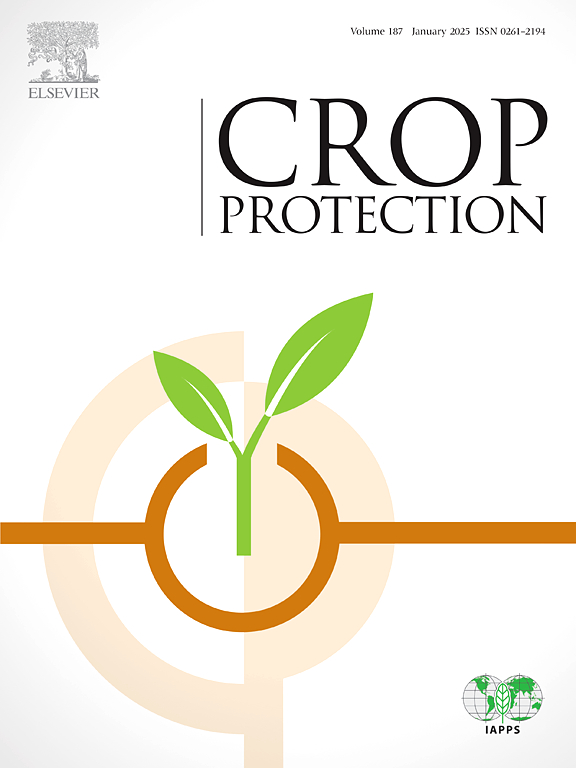Herbicide selectivity and efficacy in weed control in canola production system
IF 2.5
2区 农林科学
Q1 AGRONOMY
引用次数: 0
Abstract
Canola is an essential oilseed in global agriculture, contributing to the economic, social, and environmental sectors due to its versatility and nutritional value. Despite the notable growth of canola in Brazil, weed management poses a challenge due to the scarcity of registered selective herbicides and the prohibition of transgenics, resulting in productivity losses. Therefore, it is crucial to develop innovative technologies and generate knowledge to guide effective weed management and facilitate the expansion of canola in the country. Field studies during the 2022/2023 growing season evaluated the selectivity of herbicides in canola production and their effectiveness in weed control. The pre-emergent treatments were: clomazone, s-metolachlor, clomazone + s-metolachlor, and no pre-emergent herbicide; and the post-emergent treatments were: quinclorac, dicamba, quinclorac + dicamba, and no post-emergent herbicide, in addition to a weed-free control. Although clomazone, quinc lorac, and dicamba are not registered for use in canola in Brazil, they showed promising results by significantly reducing weed interference without negatively impacting oil and protein contents or yield components. Combinations S-metolachlor + clomazone and quinclorac + dicamba, provided the best outcomes in both weed control and grain productivity, with yields reaching 2053.29 kg ha−1 in Lavras. These findings suggest that the tested herbicides have potential for selective use in canola production, paving the way for further studies aimed at their registration and incorporation into production systems.
油菜籽生产系统除草剂防治杂草的选择性和有效性研究
油菜籽是全球农业中必不可少的油籽,由于其多功能性和营养价值,对经济、社会和环境部门做出了贡献。尽管巴西的油菜籽产量显著增长,但由于注册的选择性除草剂稀缺和禁止转基因,杂草管理面临挑战,导致生产力损失。因此,开发创新技术和知识来指导有效的杂草管理和促进油菜籽在该国的推广至关重要。在2022/2023生长季进行了田间试验,评价了除草剂在油菜生产中的选择性和除草效果。苗期前处理为:氯马酮+ s-异甲草胺,氯马酮+ s-异甲草胺,不使用苗期除草剂;苗期后的处理是:二氯氰胺,麦草畏,二氯氰胺+麦草畏,苗期后除无杂草控制外不使用除草剂。虽然氯马唑酮、喹氯敌敌畏和麦草畏没有在巴西注册用于油菜,但它们显示出有希望的结果,显著减少了杂草的干扰,而不会对油脂和蛋白质含量或产量成分产生负面影响。s -甲草胺+氯马酮和喹氯灭+麦草畏组合在防治杂草和提高粮食产量方面效果最好,Lavras的产量达到2053.29 kg ha - 1。这些发现表明,经过测试的除草剂在油菜籽生产中具有选择性使用的潜力,为进一步研究其注册和纳入生产系统铺平了道路。
本文章由计算机程序翻译,如有差异,请以英文原文为准。
求助全文
约1分钟内获得全文
求助全文
来源期刊

Crop Protection
农林科学-农艺学
CiteScore
6.10
自引率
3.60%
发文量
200
审稿时长
29 days
期刊介绍:
The Editors of Crop Protection especially welcome papers describing an interdisciplinary approach showing how different control strategies can be integrated into practical pest management programs, covering high and low input agricultural systems worldwide. Crop Protection particularly emphasizes the practical aspects of control in the field and for protected crops, and includes work which may lead in the near future to more effective control. The journal does not duplicate the many existing excellent biological science journals, which deal mainly with the more fundamental aspects of plant pathology, applied zoology and weed science. Crop Protection covers all practical aspects of pest, disease and weed control, including the following topics:
-Abiotic damage-
Agronomic control methods-
Assessment of pest and disease damage-
Molecular methods for the detection and assessment of pests and diseases-
Biological control-
Biorational pesticides-
Control of animal pests of world crops-
Control of diseases of crop plants caused by microorganisms-
Control of weeds and integrated management-
Economic considerations-
Effects of plant growth regulators-
Environmental benefits of reduced pesticide use-
Environmental effects of pesticides-
Epidemiology of pests and diseases in relation to control-
GM Crops, and genetic engineering applications-
Importance and control of postharvest crop losses-
Integrated control-
Interrelationships and compatibility among different control strategies-
Invasive species as they relate to implications for crop protection-
Pesticide application methods-
Pest management-
Phytobiomes for pest and disease control-
Resistance management-
Sampling and monitoring schemes for diseases, nematodes, pests and weeds.
 求助内容:
求助内容: 应助结果提醒方式:
应助结果提醒方式:


